
Inclined Belt Conveyor
Realize the transportation of bulk or packaged materials with various inclination angles of 0-90°, and can achieve inclined transportation that cannot be realized by ordinary belt conveyors. The special belt design can prevent materials from slipping.
Conveying angle: ≤90 degrees
Belt speed: 0.6~2.0m/s
Conveying capacity: 500 cubic meters per hour
Introduction of Inclined Belt Conveyor
Inclined belt conveyors are used to transport material between different levels or heights. Unlike horizontal conveyor systems, which move material along flat surfaces, inclined belt conveyors use angled belts to move material up or down an incline. In order to prevent items from slipping during conveying, the inclined belt conveyor is designed with side corrugated baffles.
Inclined belt conveyors can be customized to meet the specific requirements of a particular application, including the length and width of the conveyor, angle of inclination, and the type of belt material used. They are often used in conjunction with other conveyor systems, such as horizontal belt conveyors or vertical lift conveyors, to transport material between multiple levels or heights.
4 different forms of Inclined Belt Conveyor
1、Inclined Belt Conveyor with Inclined Faces Only:The most common type of Inclined Belt Conveyor is usually used independently for household or small-volume material transportation, with the lowest cost budget.

2、Inclined Belt Conveyor with Horizontal Feed End:Increase the reserved space at the horizontal feeding end, usually used with feeding equipment such as screw feeder or vibrating feeder at the feeding end, and multiple feeding equipment can be placed.
3、Inclined Belt Conveyor with Horizontal Discharge End:Increase the reserved space at the horizontal discharge end, usually used in conjunction with packaging machines, screening machines or other conveying equipment, to fill the conveying gap between the lower end machines.
4、Z-Type Inclined Belt Conveyor:The shape of the machine is similar to the letter "Z", and it is usually used in the production line of a food processing factory, and it is used with the feeding system and the packaging processing system.
Inclined Belt Conveyor's maximum inclination angle
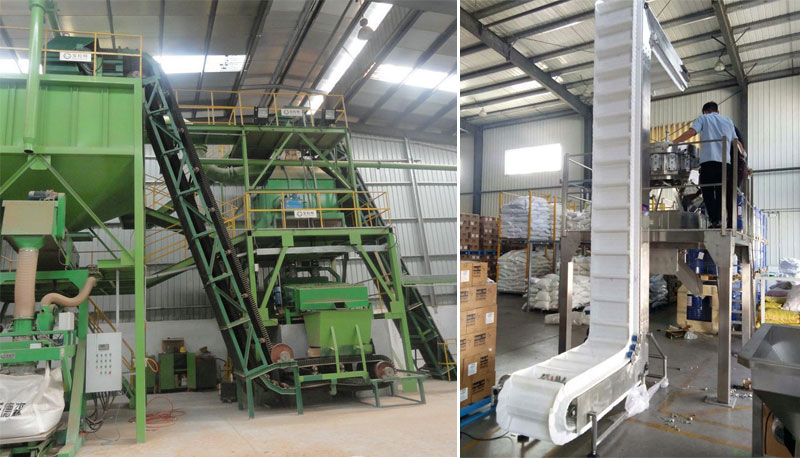
The common ones are 30 degrees and 45 degrees. If the angle is larger, the belt conveyor will be difficult to convey because the angle is too large. At this time, it is necessary to choose a belt with friction. When making a climbing belt conveyor, it is usually necessary Choose a belt with partitions or add corrugated ribs on the side of the belt to prevent objects from falling during climbing. This design can achieve 90-degree vertical transportation.
The specific maximum inclination angle for an inclined belt conveyor will depend on the specific factors and requirements of the application. It is recommended to consult with a conveyor system expert to determine the appropriate maximum inclination angle for a specific application.
Application

The Inclined Belt Conveyor can transport bulk products or packaged goods with a volume specific gravity of 0.5-2.5t/m3 within the working environment humidity range of -15°C-+40°C. It is very suitable for conveying materials from low to high between mezzanine and floor, wharf, overhead equipment and floor, and realizes the free choice of inclination angle of 0-90°.
It can be used in grain feed, parts assembly, packaging materials, palletized products, shipping/receiving materials, mines, farms, food processing plants, etc., and can also be used in conjunction with machines such as feeders, mixers, and pulverizers.
Why choose Inclined Belt Conveyor?
There are many options for inclined lifting or conveying, why use Inclined Belt Conveyor?
There are three reasons why you should choose Inclined Belt Conveyor:
1. Among all inclined conveyor systems, Inclined Belt Conveyor is the lowest cost option, which can save about 20%~30% of your budget;
2. Compared with Auger Conveyor, which has complex structures such as reducer, pipe groove, and screw shaft, Inclined Belt Conveyor can complete the transportation from point A to point B and point C with only the simplest structure, and it is reliable in operation and simple in operation. And the simple structure also means easy maintenance;
3. Your material situation also determines the choice. The open conveying environment of Inclined Belt Conveyor means that there will be no blockage, and when the material you need to convey is expensive, fragile and large or irregular in shape (such as potato chips, candy, fruit, parcels, orders, etc.), Inclined Belt Conveyor is undoubtedly the best choice.
Video
Inclined belt conveyor carries cartons upstairs
Inclined Belt Conveyor conveys Drink bottles
Features and Benefits
Space utilization: Inclined belt conveyors can transport material between different levels or heights, allowing for better use of available space in facilities with limited floor space.
Increased Efficiency: Inclined belt conveyors help increase the efficiency of material handling operations by allowing material to be transported up or down an incline, reducing the need for manual handling or additional equipment.
Flexibility: Can be customized to meet the specific requirements of a particular application, including conveyor length and width, angle of inclination, and type of belt material used. This flexibility allows inclined belt conveyors to be adapted to a wide range of applications.
Reduced labor costs: The need for manual labor in material handling operations can be reduced by automating the transport of materials between different levels or heights.
Improved Safety: Helps improve the safety of material handling operations by reducing the need to manually handle heavy or bulky materials.

Technical Parameters
| bandwidthB(mm) | 300 | 400 | 500 | 650 | 800 | |||||||||
| sidewall height(mm) | 40 | 60 | 60 | 80 | 80 | 120 | 120 | 160 | 120 | 160 | 200 | 240 | ||
| Partial conveying inclination conveying amountQ3/h | 30° | 15 | 14 | 20 | 34 | 46 | 71 | 104 | 120 | 128 | 157 | 195 | 235 | |
| 45° | 11 | 10 | 14 | 26 | 35 | 57 | 83 | 97 | 102 | 127 | 157 | 195 | ||
| 60° | 8 | 7 | 10 | 18 | 25 | 40 | 58 | 69 | 72 | 90 | 112 | 142 | ||
| 90° | 4 | 4 | 5 | 10 | 13 | 21 | 31 | 37 | 38 | 48 | 60 | 76 | ||
| Dimensions | Head wheel center heightH2/h(MM) | 350-100 | 1100-2000 | 1300-2000 | 1300-2000 | |||||||||
| Tail wheel center heightH2/h(MM) | 335 | 330-490 | 600 | 600 | 600-800 | |||||||||
| Middle section belt heightH2/h(MM) | 450 | 500-700 | 760-800 | 800-850 | 800-1115 | |||||||||
| Middle foot widthB2/h(MM) | 480 | 580 | 870 | 1020 | 1220 | |||||||||
| bandwidthB(mm) | 1000 | 1200 | 1400 | |||||||||||
| sidewall height(mm) | 120 | 160 | 200 | 240 | 160 | 200 | 240 | 300 | 160 | 200 | 240 | 300 | 400 | |
| Partial conveying inclination conveying amountQ3/h | 30° | 172 | 216 | 267 | 327 | 275 | 331 | 419 | 466 | 319 | 395 | 500 | 564 | 794 |
| 45° | 137 | 175 | 216 | 271 | 222 | 267 | 347 | 384 | 258 | 318 | 414 | 465 | 680 | |
| 60° | 96 | 124 | 153 | 197 | 158 | 190 | 253 | 178 | 184 | 226 | 302 | 337 | 524 | |
| 90° | 51 | 66 | 83 | 106 | 85 | 102 | 136 | 149 | 98 | 121 | 162 | 180 | 281 | |
| Dimensions | Head wheel center heightH2/h(MM) | 1400-2000 | 1600-2000 | |||||||||||
| Tail wheel center heightH2/h(MM) | 600-800 | 800-1000 | 800-1200 | |||||||||||
| Middle section belt heightH2/h(MM) | 800-1200 | 1050-1500 | 1050-1700 | |||||||||||
| Middle foot widthB2/h(MM) | 1440 | 1690 | 1890 | |||||||||||
Structure of the Inclined Belt Conveyor

Inclined belt conveyor is mainly composed of corrugated sidewall conveyor belt, driving device, transmission roller, redirecting roller, pinch roller, idler, idler roller, vertical roller, flapping wheel cleaning device, tensioning device and other parts. Its structure is to stick free-stretching rubber corrugated vertical "skirts" on both sides of the flat rubber conveyor belt, and between the skirts there is a certain strength and elasticity of the diaphragm to form a box-shaped bucket, so that the material can be continuously delivery.
Inclined Belt Conveyor optional

Belt Material: The choice of belt material can be customized to meet the specific requirements of the application. Common conveyor belt materials include rubber, PVC, polyurethane, etc., which can be selected according to the weight, size, use environment, and required friction coefficient of the conveyed material.
Belt Width and Length: Belt width and length can be customized to meet the specific requirements of the application. The width of the belt will depend on the size of the material being transported, while the length of the belt will depend on the distance between the two ends of the conveyor.
Tilt Angle: The tilt angle can be customized to meet the specific requirements of the application. The maximum angle of inclination depends on the type of belt material used, the weight and size of the material being transported, and the operating conditions of the conveyor system.
Cleats and Sidewalls: Cleats and sidewalls can be added to conveyor belts to help prevent material from slipping or sliding during transport. Cleats are raised portions on the belt that help grip material, while sidewalls are raised edges that help contain material.
Drive System: The type of drive system used to power the belt can be customized to meet the specific requirements of the application. Common drive systems include electric motors, hydraulic motors and air motors.
Accessories: Inclined belt conveyors are available in a variety of accessories, including sensors to monitor belt tension, speed and alignment, as well as safety features such as emergency stop switches and guardrails.
Inclined Belt Conveyor Design Factors to Consider

1. Space limitation
If the actual installation space is not plentiful, then the space size that can prevent the machine is the first consideration. Choose the ideal conveying angle within the surface area that can accommodate the Inclined Belt Conveyor.
2. Conveying angle and rib height
If your expected conveying angle does not exceed 30°, then there is no need to consider too many design factors. If you need a larger conveying angle, choose a higher rib and a higher-power motor to avoid excessive material slipping.
3. Product size (package category)
The product size includes the length and height of the material you need to convey, and also consider the weight and center of gravity of the load, in order to avoid the product from dumping or rolling during the conveying process.
4. Conveyor belt type
It mainly refers to whether your materials need to be selected for special belt materials. For example, food materials choose oil-resistant and high-temperature-resistant food-grade PU conveyor belts; for example, if you choose to transport miner materials, then choose thick and wear-resistant industrial conveyor belts.
Solutions by Industry
-
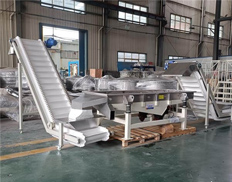
Inclined Belt Conveyor & Linear Vibrating Screen
-

Two Inclined Belt Conveyors work together
-

Inclined Belt Conveyor & Vibrating feeder
-
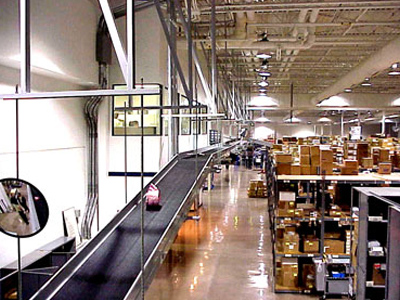
Express Center Inclined Belt Conveyor, used to transport express parcels.
Tilt angle: 10°
-
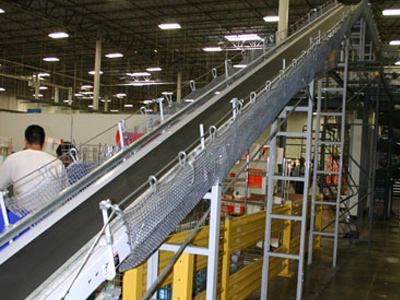
Transport the items to the Inclined Belt Conveyor on the upper interlayer, and install protective nets to prevent the items from falling.
Tilt angle: 40°
-

The Inclined Belt Conveyor transports the products picked by the picking system to the overhead belt conveyor.
Tilt angle: 60°
-
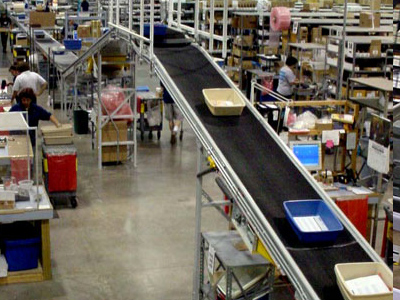
Inclined Belt Conveyor is used to transport the orders that have been picked.
Tilt angle: 15°


